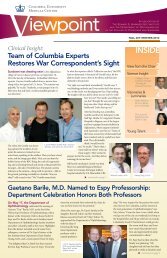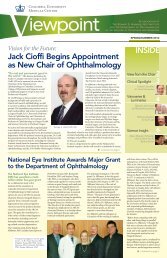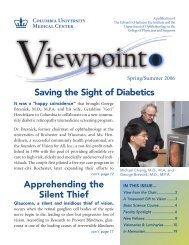Faculty Spotlight - Department of Ophthalmology, Columbia University
Faculty Spotlight - Department of Ophthalmology, Columbia University
Faculty Spotlight - Department of Ophthalmology, Columbia University
You also want an ePaper? Increase the reach of your titles
YUMPU automatically turns print PDFs into web optimized ePapers that Google loves.
Amilia Schrier, M.D.<br />
“I feel lucky and honored<br />
to work here,” says Amilia Schrier,<br />
M.D. with enthusiasm. Dr. Schrier<br />
is the new A. Gerard DeVoe–B.<br />
Dobli Srinivasan Director <strong>of</strong><br />
Ambulatory Eye Care for the ITT<br />
Eye Clinic at the Harkness Eye<br />
Institute and an associate clinical<br />
pr<strong>of</strong>essor <strong>of</strong> ophthalmology. As the<br />
former associate director <strong>of</strong> the Eye<br />
Clinic, she was a natural choice to<br />
succeed her mentor, B. Dobli<br />
Srinivasan, M.D., upon his retirement<br />
in 2006.<br />
Dr. Schrier, who holds an undergraduate<br />
degree in biology from<br />
the <strong>University</strong> <strong>of</strong> Virginia, earned<br />
her medical degree from SUNY<br />
Downstate Medical School, where<br />
she also completed her residency.<br />
In 1992, following a fellowship in<br />
Cornea and External Disease at<br />
North Shore <strong>University</strong><br />
Hospital/Cornell Medical College,<br />
she began a private ophthalmology<br />
practice on Long Island and joined<br />
co-repressor (a protein that binds<br />
with RNR in photoreceptors).<br />
Next, they tag each protein with a<br />
separate fluorescent marker. When<br />
mixed together, RNR and the corepressor<br />
bind to form a complex,<br />
and the energy from one fluorescent<br />
tag is transferred to the other.<br />
However, when a successful agonist<br />
(or ligand) is added, the agonist<br />
binds to RNR, disrupting the interaction<br />
with the co-repressor. When<br />
the interaction between RNR and<br />
the co-repressor is interrupted, it is<br />
impossible for energy to transfer<br />
from one tag to another. When that<br />
occurs, it means that the agonist<br />
the faculty <strong>of</strong> Manhattan<br />
Eye, Ear & Throat Hospital,<br />
rising to Assistant Chief <strong>of</strong><br />
Service. In 1998, Dr. Schrier<br />
joined <strong>Columbia</strong>’s<br />
<strong>Department</strong> <strong>of</strong><br />
<strong>Ophthalmology</strong>.<br />
As testimony to her gift for<br />
teaching, Dr. Schrier has<br />
been named “Outstanding<br />
Teacher <strong>of</strong> the Year” no less<br />
than six times since 1992 –<br />
once at SUNY Downstate, three<br />
times at Manhattan Eye, Ear &<br />
Throat and twice at <strong>Columbia</strong>. “I<br />
love working with residents,” she<br />
says with a warm smile. “I allow<br />
myself to be challenged by these<br />
brilliant young minds and open to<br />
their new ideas. I also feel a<br />
responsibility to teach medical<br />
ethics and compassion – the<br />
human side <strong>of</strong> being a physician. I<br />
learned the most through observing<br />
my mentors and hope to give<br />
our residents the same experience.”<br />
One <strong>of</strong> the most influential mentors<br />
in Dr. Schrier’s career was<br />
Arthur Wolintz, M.D., the former<br />
ophthalmology chair <strong>of</strong> SUNY<br />
Downstate. “He is a brilliant and<br />
inspiring man. He didn’t need to<br />
speak loudly to get his point<br />
across,” she recalls. “I remember<br />
him most for his passion for ophthalmology<br />
and medicine, as well<br />
as his gentleness.” Other important<br />
mentors include her husband,<br />
Edward Smith, M.D., and Eric<br />
Donnenfeld, M.D., Henry Perry,<br />
(the potential drug compound)<br />
has bound to RNR (the drug<br />
target). In high throughput<br />
screening, Dr. Petrukhin can very<br />
quickly test a nanoplate assay <strong>of</strong><br />
3,456 potential agonists in twomicroliter<br />
wells against the<br />
RNR/co-repressor mixture.<br />
Concurrently, Dr. Petrukhin is collaborating<br />
with associate pr<strong>of</strong>essor<br />
Lawrence Shapiro, Ph.D. to develop<br />
a three-dimensional computer<br />
model <strong>of</strong> the RNR protein through<br />
the process <strong>of</strong> x-ray crystallization<br />
[see Fall 2004 Viewpoint]. With this<br />
3D model <strong>of</strong> RNR, they can<br />
Vıewpoınt 6 SPRING/SUMMER 2007<br />
Charles Manley<br />
<strong>Faculty</strong> <strong>Spotlight</strong>:<br />
Amilia Schrier, M.D.<br />
M.D. and her entire team at<br />
Manhattan Eye, Ear & Throat.<br />
Speaking <strong>of</strong> her <strong>Columbia</strong> mentors,<br />
she notes, “Dr. Stanley Chang<br />
is a powerful, yet quiet leader<br />
whose expertise and perfection I<br />
admire tremendously. Of course,<br />
Dr. Srinivasan has been a pr<strong>of</strong>ound<br />
mentor and inspiration. His gentlemanly<br />
guidance and ‘medicine<br />
first’ approach have prepared me<br />
for this new role in directing the<br />
Eye Clinic.”<br />
Dr. Schrier acknowledges that leading<br />
the ITT Eye Clinic is an enormous<br />
responsibility. In 2006, the<br />
Eye Clinic served a total <strong>of</strong> 22,500<br />
people, up 7% from 2005.<br />
Approximately 95% <strong>of</strong> clinic<br />
patients are from the neighboring<br />
Washington Heights community<br />
and many are recent immigrants<br />
from the Dominican Republic.<br />
“It takes a large machine to make<br />
it all work,” Dr. Schrier says. The<br />
general and specialty clinics are<br />
staffed by 10 residents, numerous<br />
attending physicans, and a staff<br />
that includes three nurses, three<br />
medical assistants, two visual field<br />
technicians, seven patient representatives<br />
and one registration coordinator.<br />
She praises the staff, adding<br />
that they are “the backbone <strong>of</strong><br />
the clinic.”<br />
“The general clinic is the intake<br />
point for all patients and the powerhouse<br />
<strong>of</strong> the whole program,”<br />
Dr. Schrier explains. Specialty<br />
Burch Funds AMD Drug Development Efforts continued from page 2<br />
explore theoretical computer<br />
“docking” in which the molecular<br />
structure <strong>of</strong> the successful agonist<br />
(the “key”) is matched to RNR’s ligand<br />
binding pocket (the “lock”). A<br />
medicinal chemist can then modify<br />
and optimize the molecular structure<br />
<strong>of</strong> the successful agonist for<br />
greater effectiveness.<br />
“I’m thrilled to have the opportunity<br />
to help in this research effort to<br />
cure AMD and to support the<br />
department’s Vision for the Future<br />
campaign,” says Mr. Burch, who<br />
previously demonstrated his support<br />
by establishing the prestigious<br />
clinics in retina, glaucoma, laser,<br />
neuro-ophthalmology, uveitis,<br />
cornea, orbit and plastics, contact<br />
lenses, and pediatrics run concurrently<br />
with the general clinic.<br />
Attending physicians staff the specialty<br />
clinics and mentor residents.<br />
“Our philosophy is ‘teach by<br />
example.’ We work together in<br />
tense and stressful situations, so<br />
we strive to be calm, rational<br />
and fair in our assessment <strong>of</strong><br />
patients and evaluation <strong>of</strong><br />
disease and treatment.”<br />
Dr. Schrier also maintains a practice<br />
specializing in cataract, cornea and<br />
external ocular disease. She mentors<br />
residents in clinical research based<br />
on observations <strong>of</strong> interesting cases<br />
from the clinic. Residents frequently<br />
present their findings at Grand<br />
Rounds, as well as at regional and<br />
international meetings.<br />
“The most rewarding aspect <strong>of</strong> my<br />
job is that it is so multifaceted. Our<br />
residents are talented young doctors<br />
who experience tremendous<br />
personal and pr<strong>of</strong>essional growth<br />
as they become excellent ophthalmologists.<br />
I also have the privilege<br />
<strong>of</strong> working with a brilliant group<br />
<strong>of</strong> colleagues and attending physicians.<br />
I am especially grateful to<br />
the patients who entrust us with<br />
their care,” Dr. Schrier reflects.<br />
“The Eye Clinic is a wonderful<br />
place to work. I am a better person<br />
and a better doctor because <strong>of</strong> it.”<br />
Robert L. Burch III Pr<strong>of</strong>essorship<br />
<strong>of</strong> <strong>Ophthalmology</strong> in 2005.<br />
“Attracting such a major talent as<br />
Dr. Petrukhin shows enormous<br />
progress toward enhancing the<br />
research capabilities <strong>of</strong> the<br />
Harkness Eye Institute and finding<br />
effective treatments for AMD.”<br />
Dr. Petrukhin is equally grateful.<br />
“Thanks to Mr. Burch’s generosity,<br />
the lab is up and running with<br />
excellent equipment and I’ve been<br />
able to hire a research associate and<br />
a post-doctoral scientist to speed<br />
our efforts. This kind <strong>of</strong> support is<br />
very much appreciated.”





